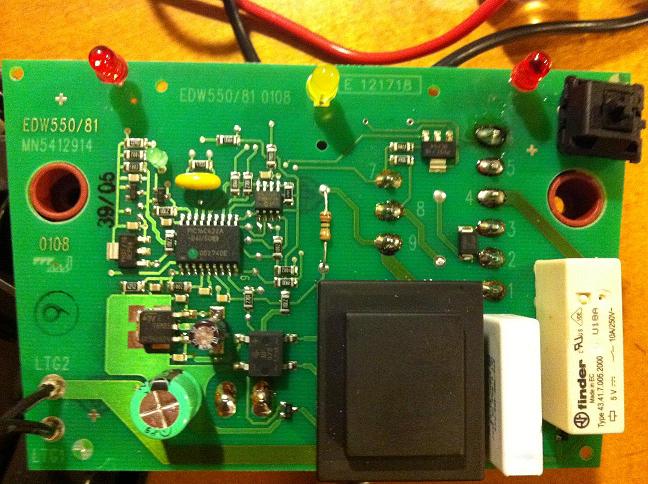
The pin is in the upper right corner, this is after I resoldered it. You can still see some of the black discoloration.
Michelle bought a Miele Silver Moon vacuum a long time ago,
seems like about 10 years plus or minus.
The good news is this vacuum is still working after 10 years.
The bad news is that it's had several failures to function over the years.
The good news is most of those problems were fixed under warranty.
The bad news is it recently failed again, out of warranty.
More bad news, a comparable new replacement model costs about $1000.
Michelle took it to a nearby Miele dealer & repair shop in Ballard. They said it was DOA, could not be repaired, though they could keep it and disard it for her. In her distress, she agreed and left it with them. When I got home I said it was worth at least a shot for me to do surgery on it. Even though my tools are only very basic - just a multimeter and soldering iron - it might be fun and educational, and we had nothing to lose. It wouldn't be the first time I got lucky and fixed something that would be expensive to replace.
Next day Michelle called the shop to reclaim her vacuum. They said they could have it ready in a few hours. Translation: they were already parting it out for core fees and spare parts like a bunch of Jawas scavenging R2D2. And it would take a few hours to put it back together.
So now I've got a dead vacuum.
Symptom: plug it in, turn it on, nothing happens.
I opened it up, checked continuity of power, etc. Long story short, it had 2 problems.
Problem 1: wimpy power supply.
The Miele draws 10+ amps of current and its power supply isn't quite up to the job.
I removed the power supply circuit board and saw that the hot power pin
was carbonized like a dirty spark plug,
all the solder had melted away from the board,
and the plastic connector below the board was slightly melted.
The parts were still servicable, though worn,
so I soldered the pin back onto the board.
I made sure to get it nice a hot with plenty of solder
for a strong solder bond with maximum surface area.
At this point the vacuum was alive but wounded. It fired up eagerly with excellent suction when turned on, but wasn't delivering power to the power head and the electronic controls on the hose handle were dark.
Here's a photo:

The pin is in the upper right corner, this is after I resoldered it.
You can still see some of the black discoloration.
Problem 2: stressed internal wire in power head hose handle
Long story short, a wire came disconnected from a small circuit board inside the handle,
because the wires running to it were too short and it was physically stressed.
In short, poor manufacturing quality.
I resoldered this wire and reoriented it during reassembly to eliminate the stress.
Now the details: First I rung out all the connectors from the power supply to the hose to find there was good continuity. Next I disassembled the power hose end that plugs into the vacuum. The internal sliding spring loaded points were tired, so I slightly bent them to give them firmer contact. But it still didn't have continuity to the electronic controls. I disassembled the handle area of the hose to find a mini circuit board with 3 wires. 1 of the 3 wires had been ripped out of the board. This was due to poor manufacturing quality. The wires were slightly too short and whoever assembled it was too lazy to do it right, so assembled it with stress on one of the wires. Over the years, it ripped the wire from the board.
After fixing this, the vacuum was alive and healthy. Michelle said next day, it worked better than it had in years. Apparently, the solder on the power supply pin had been gradually reducing effective surface area, limiting power to the motor. Now it had full surface area, full power and great suction. Also, the hose controls had been intermittently going dead, but were now working reliably.